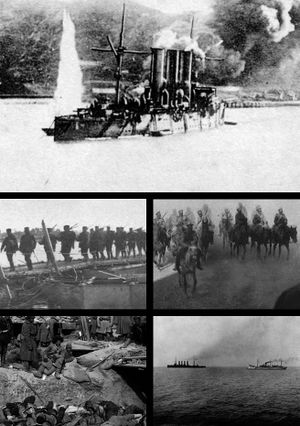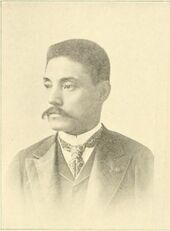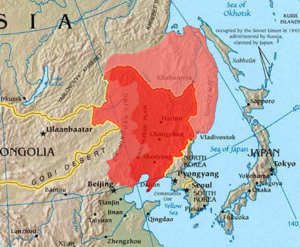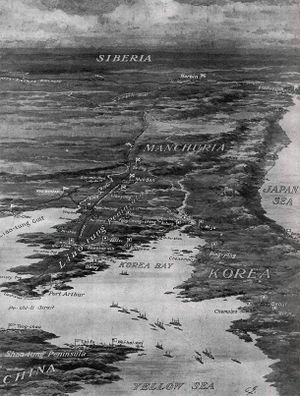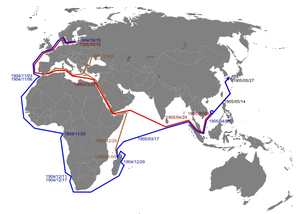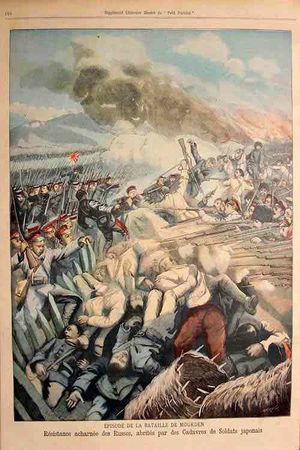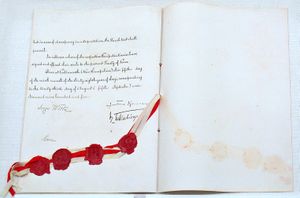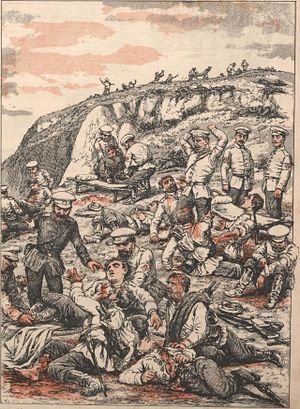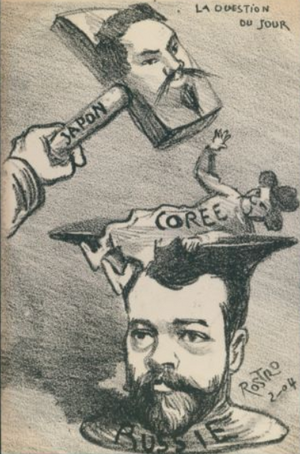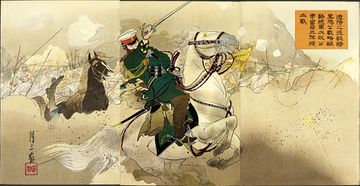الحرب الروسية اليابانية
| ||||||||||||||||||||||||||||
الحرب اليابانية الروسية (روسية: Русско-японская война, romanized: Russko-japonskaja vojna; يابانية: 日露戦争؛ إنگليزية: Russo-Japanese War ؛ بدأت في 10 فبراير 1904 - 5 سبتمبر 1905، بسبب صراع لاستعمار كوريا حيث كانت روسيا قد تغلغلت في تلك المناطق, ورفضت التفاوض مع اليابان لتقسيم مناطق النفوذ. ودون اعلان الحرب هاجمت اليابان پورت آرثر وحاصرت الاسطول الروسي وانتزعت اليابان بورت ارثر و هزموا الروس في مكدن 1905 في معركة تسوشيما حيث حطم اسطول روسي كبير. وقع الصلح بتوسط تيودور روزڤلت وساعدت هذه الحرب اليابان لتصبح قوة عظمى كما ساعدت على اندلاع الثورة الروسية.
وقعت الدولتان في أول الأمر اتفاقا تم بموجبه إعلان كوريا منطقة محايدة، إلا أنه وبعد انتفاضة الأهالي في الصين (1898) أخذت روسيا تختلق الذرائع لتبرير احتلاها لـ"منشوريا" وتقدم قواتها إلى كوريا.
كانت اليابان قد قطعت شوطا كبيرا في تطوير صناعتها العسكرية وتحديث جيشها، عمل اليابانيون على الظهور بمظهر مخلص الشعوب الآسيوية من القوى الغربية. بعد توقيعها لاتفاقية تحالف مع بريطانيا عام 1902، رأت الحكومة اليابانية أن الفرصة مواتية للتحرك. قدمت اليابان طلبا رسميا لروسيا حتى تسحب قواتها المتمركزة في منشوريا، رغم طول المفاوضات وإصرار اليابانيين رفض الروس.
بدأت القوات اليابانية بمهاجمة ميناء "پورت آرثر" في "منشوريا"، والذي كانت تحت سيطرة القوات الروسية، ثم أعلنت الحكومة اليابانية رسميا الحرب على روسيا اليوم العاشر من شهر فبراير من عام 1904. دحر الأسطول الياباني القوات البحرية الروسية في أول مواجهة بينها في "تسوشيما". على البر رغم تقدمها إلا القوات اليابانية تكبدت خسائر فادحة.
. . . . . . . . . . . . . . . . . . . . . . . . . . . . . . . . . . . . . . . . . . . . . . . . . . . . . . . . . . . . . . . . . . . . . . . . . . . . . . . . . . . . . . . . . . . . . . . . . . . . . . . . . . . . . . . . . . . . . . . . . . . . . . . . . . . . . . . . . . . . . . . . . . . . . . . . . . . . . . . . . . . . . . . .
الخلفية التاريخية
عصرنة اليابان
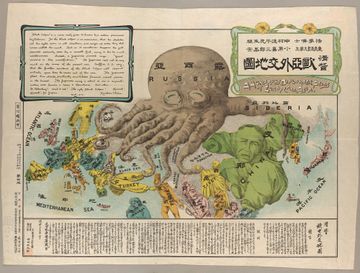
After the Meiji Restoration in 1868, the Meiji government endeavoured to assimilate Western ideas, technological advances and ways of warfare. By the late 19th century, Japan had transformed itself into a modernized industrial state. The Japanese wanted to be recognized as equal with the Western powers. The Meiji Restoration had been intended to make Japan a modernized state, not a Westernized one, and Japan was an imperialist power, looking towards overseas expansionism.[5]
In the years 1869–73, the Seikanron ("Conquer Korea Argument") had bitterly divided the Japanese elite: one faction wanted to conquer Korea immediately, another wanted to wait until Japan was further modernized before embarking on a war to conquer Korea; significantly, no one in the Japanese elite ever accepted the idea that the Koreans had the right to be independent, with only the question of timing dividing the two factions.[6] In much the same way that Europeans used the "backwardness" of African and Asian nations as a reason for why they had to conquer them, for the Japanese elite the "backwardness" of China and Korea was proof of the inferiority of those nations, thus giving the Japanese the "right" to conquer them.[7]
Count Inoue Kaoru, the Foreign Minister, gave a speech in 1887 saying "What we must do is to transform our empire and our people, make the empire like the countries of Europe and our people like the peoples of Europe," going on to say that the Chinese and Koreans had essentially forfeited their right to be independent by not modernizing.[7] Much of the pressure for an aggressive foreign policy in Japan came from below, with the advocates of "people's rights" movement calling for an elected parliament also favouring an ultra-nationalist line that took it for granted the Japanese had the "right" to annex Korea, as the "people's rights" movement was led by those who favoured invading Korea in the years 1869–73.[7]
As part of the modernization process in Japan, Social Darwinist ideas about the "survival of the fittest" were common from the 1880s onward and many ordinary Japanese resented the heavy taxes imposed by the government to modernize Japan, demanding something tangible like an overseas colony as a reward for their sacrifices.[8]
Furthermore, the educational system of Meiji Japan was meant to train the schoolboys to be soldiers when they grew up, and as such, Japanese schools indoctrinated their students into Bushidō ("way of the warrior"), the fierce code of the samurai.[7] Having indoctrinated the younger generations into Bushidō, the Meiji elite found themselves faced with a people who clamored for war, and regarded diplomacy as a weakness.[7]
الضغط الشعبي
The British Japanologist Richard Storry wrote that the biggest misconception about Japan in the West was that the Japanese people were the "docile" instruments of the elite, when in fact much of the pressure for Japan's wars from 1894 to 1941 came from the ordinary people, who demanded a "tough" foreign policy, and tended to engage in riots and assassination when foreign policy was perceived to be pusillanimous.[7]
Though the Meiji oligarchy refused to allow liberal democracy, they did seek to appropriate some of the demands of the "people's rights" movement by allowing an elected Imperial Diet in 1890 (with limited powers and an equally limited franchise) and by pursuing an aggressive foreign policy towards Korea.[7]
In 1884, Japan had encouraged a coup in the Kingdom of Korea by a pro-Japanese reformist faction, which led to the conservative government calling upon China for help, leading to a clash between Chinese and Japanese soldiers in Seoul.[9] At the time, Tokyo did not feel ready to risk a war with China, and the crisis was ended by the Convention of Tientsin, which left Korea more strongly in the Chinese sphere of influence, though it did give the Japanese the right to intervene in Korea.[9] All through the 1880s and early 1890s, the government in Tokyo was regularly criticized for not being aggressive enough in Korea, leading Japanese historian Masao Maruyama to write:
Just as Japan was subject to pressure from the Great Powers, so she would apply pressure to still weaker countries—a clear case of the transfer psychology. In this regard it is significant that ever since the Meiji period demands for a tough foreign policy have come from the common people, that is, from those who are at the receiving end of oppression at home.[9]
التوسع الروسي شرقاً
Tsarist Russia, as a major imperial power, had ambitions in the East. By the 1890s it had extended its realm across Central Asia to Afghanistan, absorbing local states in the process. The Russian Empire stretched from Poland in the west to the Kamchatka Peninsula in the east.[10] With its construction of the Trans-Siberian Railway to the port of Vladivostok, Russia hoped to further consolidate its influence and presence in the region. In the Tsushima incident of 1861 Russia had directly assaulted Japanese territory.
الحرب الصينية اليابانية (1894-1895)
 مقالة مفصلة: الحرب الصينية اليابانية الأولى
مقالة مفصلة: الحرب الصينية اليابانية الأولى

The first major war the Empire of Japan fought following the Meiji Restoration was against China, from 1894 to 1895. The war revolved around the issue of control and influence over Korea under the rule of the Joseon dynasty. From the 1880s onward, there had been vigorous competition for influence in Korea between China and Japan.[11] The Korean court was prone to factionalism, and at the time was badly divided between a reformist camp that was pro-Japanese and a more conservative faction that was pro-Chinese.[11] In 1884, a pro-Japanese coup attempt was put down by Chinese troops, and a "residency" under General Yuan Shikai was established in Seoul.[11] A peasant rebellion led by the Tonghak religious movement led to a request by the Korean government for the Qing dynasty to send in troops to stabilize the country.[11] The Empire of Japan responded by sending their own force to Korea to crush the Tonghak and installed a puppet government in Seoul. China objected and war ensued. Hostilities proved brief, with Japanese ground troops routing Chinese forces on the Liaodong Peninsula and nearly destroying the Chinese Beiyang Fleet in the Battle of the Yalu River. Japan and China signed the Treaty of Shimonoseki, which ceded the Liaodong Peninsula and the island of Taiwan to Japan. After the peace treaty, Russia, Germany, and France forced Japan to withdraw from the Liaodong Peninsula. The leaders of Japan did not feel that they possessed the strength to resist the combined might of Russia, Germany and France, and so gave in to the ultimatum. At the same time, the Japanese did not abandon their attempts to force Korea into the Japanese sphere of influence. On 8 October 1895, Queen Min of Korea, the leader of the anti-Japanese and pro-Chinese faction at the Korean court was murdered by Japanese agents within the halls of the Gyeongbokgung palace, an act that backfired badly as it turned Korean public opinion against Japan.[12] In early 1896, King Gojong of Korea fled to the Russian legation in Seoul, believing that his life was in danger from Japanese agents, and Russian influence in Korea started to predominate.[12] In the aftermath of the flight of the king, a popular uprising overthrew the pro-Japanese government and several cabinet ministers were lynched on the streets.[12]
In 1897, Russia occupied the Liaodong Peninsula, built the Port Arthur fortress, and based the Russian Pacific Fleet in the port. Russia's acquisition of Port Arthur was primarily an anti-British move to counter the British occupation of Wei-hai-Wei, but in Japan, this was perceived as an anti-Japanese move.[13] Germany occupied Jiaozhou Bay, built the Tsingtao fortress, and based the German East Asia Squadron in this port. Between 1897 and 1903, the Russians built the Chinese Eastern Railway (CER) in Manchuria.[14] The Chinese Eastern Railroad was owned jointly by the Russian and Chinese governments, but the company's management was entirely Russian, the line was built to the Russian gauge and Russian troops were stationed in Manchuria to protect rail traffic on the CER from bandit attacks.[14] The headquarters of the CER company was located in the new Russian-built city of Harbin, the "Moscow of the Orient". From 1897 onwards, Manchuria—while still nominally part of the "Great Qing Empire"—started to resemble more and more a Russian province.[14]
الانتهاك الروسي
In December 1897, a Russian fleet appeared off Port Arthur. After three months, in 1898, China and Russia negotiated a convention by which China leased (to Russia) Port Arthur, Talienwan and the surrounding waters. The two parties further agreed that the convention could be extended by mutual agreement. The Russians clearly expected such an extension, for they lost no time in occupying the territory and in fortifying Port Arthur, their sole warm-water port on the Pacific coast and of great strategic value. A year later, to consolidate their position, the Russians began to build a new railway from Harbin through Mukden to Port Arthur, the South Manchurian Railroad.[14] The development of the railway became a contributory factor to the Boxer Rebellion, when Boxer forces burned the railway stations.[15]
The Russians also began to make inroads into Korea. By 1898 they had acquired mining and forestry concessions near the Yalu and Tumen rivers,[16] causing the Japanese much anxiety. Japan decided to attack before the Russians completed the Trans-Siberian Railway.
تمرد الملاكمين
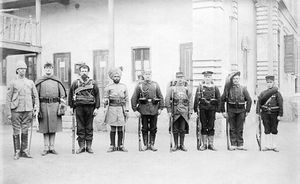
The Russians and the Japanese both contributed troops to the eight-member international force sent in 1900 to quell the Boxer Rebellion and to relieve the international legations under siege in the Chinese capital, Beijing. Russia had already sent 177,000 soldiers to Manchuria, nominally to protect its railways under construction. The troops of the Qing Empire and the participants of the Boxer Rebellion could do nothing against such a massive army and were ejected from Manchuria. After the Boxer Rebellion, 100,000 Russian soldiers were stationed in Manchuria.[17] The Russian troops settled in[18] and despite assurances they would vacate the area after the crisis, by 1903 the Russians had not established a timetable for withdrawal[19] and had actually strengthened their position in Manchuria.
. . . . . . . . . . . . . . . . . . . . . . . . . . . . . . . . . . . . . . . . . . . . . . . . . . . . . . . . . . . . . . . . . . . . . . . . . . . . . . . . . . . . . . . . . . . . . . . . . . . . . . . . . . . . . . . . . . . . . . . . . . . . . . . . . . . . . . . . . . . . . . . . . . . . . . . . . . . . . . . . . . . . . . . .
مفاوضات ما قبل الحرب
The Japanese statesman Itō Hirobumi started to negotiate with the Russians. He regarded Japan as too weak to evict the Russians militarily, so he proposed giving Russia control over Manchuria in exchange for Japanese control of northern Korea. Of the five Genrō (elder statesmen) who made up the Meiji oligarchy, Itō Hirobumi and Count Inoue Kaoru opposed the idea of war against Russia on financial grounds, while Katsura Tarō, Komura Jutarō and Field Marshal Yamagata Aritomo favored war.[20] Meanwhile, Japan and Britain had signed the Anglo-Japanese Alliance in 1902 – the British seeking to restrict naval competition by keeping the Russian Pacific seaports of Vladivostok and Port Arthur from their full use. Japan's alliance with the British meant, in part, that if any nation allied itself with Russia during any war against Japan, then Britain would enter the war on Japan's side. Russia could no longer count on receiving help from either Germany or France without the danger of British involvement in the war. With such an alliance, Japan felt free to commence hostilities if necessary.[بحاجة لمصدر]
When Nicholas replied that he still wanted peace, Wilhelm wrote back in a telegram "You innocent angel!", telling his advisors "This is the language of an innocent angel. But not that of a White Tsar!"[21] Nevertheless, Tokyo believed that Russia was not serious about seeking a peaceful solution to the dispute. On 13 January 1904, Japan proposed a formula by which Manchuria would remain outside Japan's sphere of influence and, reciprocally, Korea outside Russia's. On 21 December 1903, the Tarō cabinet voted to go to war against Russia.[22]
By 4 February 1904, no formal reply had been received from Saint Petersburg. On 6 February the Japanese minister to Russia, Kurino Shin'ichirō, was recalled, and Japan severed diplomatic relations with Russia.[23]
Potential diplomatic resolution of territorial concerns between Japan and Russia failed; historians have argued that this directly resulted from the actions of Emperor Nicholas II. Crucially, Nicholas mismanaged his government. Although certain scholars contend that the situation arose from the determination of Nicholas II to use the war against Japan to spark a revival in Russian patriotism, no historical evidence supports this claim.[24] The Tsar's advisors did not support the war, foreseeing problems in transporting troops and supplies from European Russia to the East.[25] The Tsar himself repeatedly delayed negotiations with the Japanese government as he believed that he was protected by God and the autocracy.[26] The Japanese understanding of this can be seen in a telegram from Japanese minister of foreign affairs, Komura, to the minister to Russia, in which he stated:
...the Japanese government have at all times during the progress of the negotiations made it a special point to give prompt answers to all propositions of the Russian government. The negotiations have now been pending for no less than four months, and they have not yet reached a stage where the final issue can with certainty be predicted. In these circumstances the Japanese government cannot but regard with grave concern the situation for which the delays in negotiations are largely responsible.[27]
Some scholars have suggested that Nicholas II dragged Japan into war intentionally, in hopes of reviving Russian nationalism. This notion conflicts with a comment made by Nicholas to Kaiser Wilhelm of Germany, saying there would be no war because he "did not wish it".[28] This does not reject the claim that Russia played an aggressive role in the East, which it did; rather, it means that Russia unwisely calculated and supposed that Japan would not go to war against Russia's far larger and seemingly superior navy and army. Nicholas held the Japanese in contempt as "yellow monkeys", and he took for granted that the Japanese would simply yield in the face of Russia's superior power, which thus explains his unwillingness to compromise.[29] Evidence of Russia's false sense of security and superiority to Japan is seen by Russian reference to Japan's choosing war as a big mistake.[30][need quotation to verify]
إعلان الحرب
Japan issued a declaration of war on 8 February 1904.[31] However, three hours before Japan's declaration of war was received by the Russian government, and without warning, the Imperial Japanese Navy attacked the Russian Far East Fleet at Port Arthur.[32]
Tsar Nicholas II was stunned by news of the attack. He could not believe that Japan would commit an act of war without a formal declaration, and had been assured by his ministers that the Japanese would not fight. When the attack came, according to Cecil Spring Rice, first secretary at the British Embassy, it left the Tsar "almost incredulous".[33]
Russia declared war on Japan eight days later.[34] Japan, in response, made reference to the Russian attack on Sweden in 1808 without declaration of war, although the requirement to mediate disputes between states before commencing hostilities was made international law in 1899, and again in 1907, with the Hague Conventions of 1899 and 1907.[35][36][37]
The kingdom of Montenegro also declared war on Japan in gratitude for Russia's political support of the Montenegrin king. The gesture was symbolic and no soldiers from the army were ever deployed in the far East but a few Montenegrins volunteered and joined the Russian army.[38]
The Qing Empire favoured the Japanese position and even offered military aid, but Japan declined it. However, Yuan Shikai sent envoys to Japanese generals several times to deliver foodstuffs and alcoholic drinks. Native Manchurians joined the war on both sides as hired troops.[39]
حملة 1904
Port Arthur, on the Liaodong Peninsula in the south of Manchuria, had been fortified into a major naval base by the Russian Imperial Army. Since it needed to control the sea in order to fight a war on the Asian mainland, Japan's first military objective was to neutralize the Russian fleet at Port Arthur.
معركة پورت آرثر
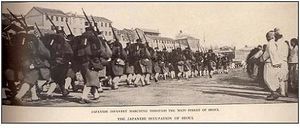
The Japanese attempted to deny the Russians use of Port Arthur. During the night of 13–14 February, the Japanese attempted to block the entrance to Port Arthur by sinking several concrete-filled steamers in the deep water channel to the port,[40] but they sank too deep to be effective. A similar attempt to block the harbour entrance during the night of 3–4 May also failed. In March, the charismatic Vice Admiral Makarov had taken command of the First Russian Pacific Squadron with the intention of breaking out of the Port Arthur blockade.
On 12 April 1904, two Russian pre-dreadnought battleships, the flagship Petropavlovsk and the Pobeda, slipped out of port but struck Japanese mines off Port Arthur. The Petropavlovsk sank almost immediately, while the Pobeda had to be towed back to port for extensive repairs. Admiral Makarov, the single most effective Russian naval strategist of the war, died on the battleship Petropavlovsk.
On 15 April 1904, the Russian government made overtures threatening to seize the British war correspondents who were taking the ship إسإس Haimun into war zones to report for the London-based Times newspaper, citing concerns about the possibility of the British giving away Russian positions to the Japanese fleet.
The Russians quickly learned, and soon employed, the Japanese tactic of offensive minelaying. On 15 May 1904, two Japanese battleships, the Yashima and the Hatsuse, were lured into a recently laid Russian minefield off Port Arthur, each striking at least two mines. The Hatsuse sank within minutes, taking 450 sailors with her, while the Yashima sank while under tow towards Korea for repairs. On 23 June 1904, a breakout attempt by the Russian squadron, now under the command of Admiral Wilgelm Vitgeft, failed. By the end of the month, Japanese artillery were firing shells into the harbour.
حصار پورت آرثر
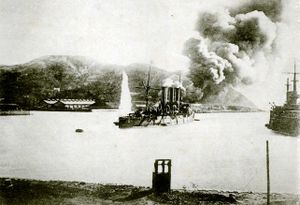
The siege of Port Arthur commenced in April 1904.[41] Japanese troops tried numerous frontal assaults on the fortified hilltops overlooking the harbour, which were defeated with Japanese casualties in the thousands.[42] With the aid of several batteries of 11-inch (280 mm) L/10 howitzers, the Japanese were eventually able to capture the key hilltop bastion in December 1904. With a spotter at the end of a phone line located at this vantage point, the long-range artillery was able to shell the Russian fleet, which was unable to retaliate against the land-based artillery invisible over the other side of hilltop, and was unable or unwilling to sail out against the blockading fleet. Four Russian battleships and two cruisers were sunk in succession, with the fifth and last battleship being forced to scuttle a few weeks later. Thus, all capital ships of the Russian fleet in the Pacific were sunk. This is probably the only example in military history when such a scale of devastation was achieved by land-based artillery against major warships.
Meanwhile, attempts to relieve the besieged city by land also failed, and, after the Battle of Liaoyang in late August, the northern Russian force that might have been able to relieve Port Arthur retreated to Mukden (Shenyang). Major General Anatoly Stessel, commander of the Port Arthur garrison, believed that the purpose of defending the city was lost after the fleet had been destroyed. In general, the Russian defenders were suffering disproportionate casualties each time the Japanese attacked. In particular, several large underground mines were exploded in late December, resulting in the costly capture of a few more pieces of the defensive line. Stessel, therefore, decided to surrender to the surprised Japanese generals on 2 January 1905. He made his decision without consulting either the other military staff present, or the Tsar and military command, all of whom disagreed with the decision. Stessel was convicted by a court-martial in 1908 and sentenced to death on account of an incompetent defense and for disobeying orders. He was later pardoned.
. . . . . . . . . . . . . . . . . . . . . . . . . . . . . . . . . . . . . . . . . . . . . . . . . . . . . . . . . . . . . . . . . . . . . . . . . . . . . . . . . . . . . . . . . . . . . . . . . . . . . . . . . . . . . . . . . . . . . . . . . . . . . . . . . . . . . . . . . . . . . . . . . . . . . . . . . . . . . . . . . . . . . . . .
التعاون الاستخباراتي الأنگلو-ياباني
Even before the war, British and Japanese intelligence had co-operated against Russia due to the Anglo-Japanese Alliance.[43] During the war, Indian Army stations in Malaya and China often intercepted and read wireless and telegraph cable traffic relating to the war, which was shared with the Japanese.[44] In their turn, the Japanese shared information about Russia with the British with one British official writing of the "perfect quality" of Japanese intelligence. In particular, British and Japanese intelligence gathered much evidence that Germany was supporting Russia in the war as part of a bid to disturb the balance of power in Europe, which led to British officials increasingly perceiving Germany as a threat to the international order.[45]
معركة نهر يالو
 مقالة مفصلة: معركة نهر يالو (1904)
مقالة مفصلة: معركة نهر يالو (1904)
In contrast to the Japanese strategy of rapidly gaining ground to control Manchuria, Russian strategy focused on fighting delaying actions to gain time for reinforcements to arrive via the long Trans-Siberian Railway, which was incomplete near Irkutsk at the time. On 1 May 1904, the Battle of Yalu River became the first major land battle of the war; Japanese troops stormed a Russian position after crossing the river. The defeat of the Russian Eastern Detachment removed the perception that the Japanese would be an easy enemy, that the war would be short, and that Russia would be the overwhelming victor.[46] This was also the first battle in decades to be an Asian victory over a European power and marked Russia's inability to match Japan's military prowess.[47] Japanese troops proceeded to land at several points on the Manchurian coast, and in a series of engagements, drove the Russians back towards Port Arthur. The subsequent battles, including the Battle of Nanshan on 25 May 1904, were marked by heavy Japanese losses largely from attacking entrenched Russian positions.
معركة البحر الأصفر
 مقالة مفصلة: معركة البحر الأصفر
مقالة مفصلة: معركة البحر الأصفر
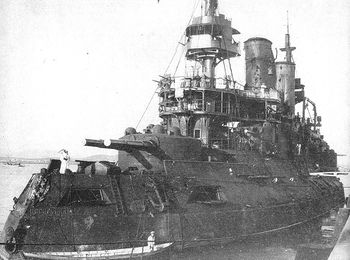
With the death of Admiral Stepan Makarov during the siege of Port Arthur in April 1904, Admiral Wilgelm Vitgeft was appointed commander of the battle fleet and was ordered to make a sortie from Port Arthur and deploy his force to Vladivostok. Flying his flag in the French-built pre-dreadnought Tsesarevich, Vitgeft proceeded to lead his six battleships, four cruisers, and 14 torpedo boat destroyers into the Yellow Sea in the early morning of 10 August 1904. Waiting for him was Admiral Tōgō and his fleet of four battleships, 10 cruisers, and 18 torpedo boat destroyers.[48]
At approximately 12:15, the battleship fleets obtained visual contact with each other, and at 13:00 with Tōgō crossing Vitgeft's T, they commenced main battery fire at a range of about eight miles, the longest ever conducted up to that time.[49] For about thirty minutes the battleships pounded one another until they had closed to less than four miles and began to bring their secondary batteries into play. At 18:30, a hit from one of Tōgō's battleships struck Vitgeft's flagship's bridge, killing him instantly.
With the Tsesarevich's helm jammed and their admiral killed in action, she turned from her battle line, causing confusion among her fleet. However, Tōgō was determined to sink the Russian flagship and continued pounding her, and it was saved only by the gallant charge of the American-built Russian battleship Retvizan, whose captain successfully drew away Tōgō's heavy fire from the Russian flagship.[50] Knowing of the impending battle with the battleship reinforcements arriving from Russia (the Baltic Fleet), Tōgō chose not to risk his battleships by pursuing his enemy as they turned about and headed back into Port Arthur, thus ending naval history's longest-range gunnery duel up to that time and the first modern clash of steel battleship fleets on the high seas.
انتقال أسطول البلطيق
Meanwhile, the Russians were preparing to reinforce their Far East Fleet by sending the Baltic Fleet, under the command of Admiral Zinovy Rozhestvensky. After a false start caused by engine problems and other mishaps, the squadron finally departed on 15 October 1904, and sailed halfway around the world from the Baltic Sea to the Pacific via the Cape Route around the Cape of Good Hope in the course of a seven-month odyssey that was to attract worldwide attention. The Dogger Bank incident on 21 October 1904, where the Russian fleet fired on British fishing boats that they mistook for enemy torpedo boats, nearly sparked a war with the United Kingdom (an ally of Japan, but neutral, unless provoked). During the voyage, the fleet separated into a portion that went through the Suez Canal while the larger battleships went around the Cape of Good Hope.
الأثر على المدنيين
It was reported in 1905 that many Russian women were raped by Japanese troops, causing a widespread infections of venereal diseases in large number of Japanese troops.[51][52] During the fighting in Manchuria, there were Russian troops that looted and burned some Chinese villages, raped women and often killed those who resisted or did not understand what they wanted.[53] The Russian justification for all this was that Chinese civilians, being Asian, must have been helping their fellow Asians (the Japanese) inflict defeat on the Russians, and therefore deserved to be punished. The Russian troops were gripped by the fear of the "Yellow Peril", and saw all Asians, not just the Japanese, as the enemy.[53] All of the Russian soldiers were much feared by the Chinese population of Manchuria, but it was the Cossacks whom they feared the most on the account of their brutality and insatiable desire to loot. Largely because of the more disciplined behavior of the Japanese, the Han and Manchu population of Manchuria tended to be pro-Japanese.[53] The Japanese were also prone to looting, albeit in a considerably less brutal manner than the Russians, and summarily executed any Chinese or Manchu whom they suspected of being spies. The city of Liaoyang had the misfortune to be sacked three times within three days: first by the Russians, then by the Chinese police, and finally by the Japanese.[53]
The Japanese hired Chinese bandits known variously as the honghuzi, hunghutze, or khunkhuzy to engage in guerrilla warfare by attacking Russian supply columns.[39] Only once did the honghuzi attack Japanese forces, and that attack was apparently motivated by the honghuzi mistaking the Japanese forces for a Russian one.[54] Zhang Zuolin, a prominent bandit leader and the future "Old Marshal" who would rule Manchuria as a warlord between 1916 and 1928, worked as a honghuzi for the Japanese. Manchuria was still officially part of the Chinese Empire, and the Chinese civil servants tried their best to be neutral as Russian and Japanese troops marched across Manchuria. In the parts of Manchuria occupied by the Japanese, Tokyo appointed "civil governors" who worked to improve health, sanitation and the state of the roads.[54] These activities were also self-interested, as improved roads lessened Japanese logistics problems while improved health amongst the Chinese lessened the dangers of diseases infecting the Japanese troops. By contrast, the Russians made no effort to improve sanitation or health amongst the Chinese, and destroyed everything when they retreated. Many Chinese tended to see the Japanese as the lesser evil.[54]
حملة 1905
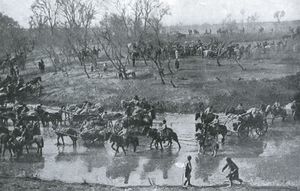
With the fall of Port Arthur, the Japanese 3rd Army could continue northward to reinforce positions south of Russian-held موكدن. With the onset of the severe Manchurian winter, there had been no major land engagements since the Battle of Shaho the previous year. The two sides camped opposite each other along 60 to 70 miles (110 km) of front lines south of Mukden.
معركة ساندپو
معركة موكدن
The Battle of Mukden commenced on 20 February 1905. In the following days Japanese forces proceeded to assault the right and left flanks of Russian forces surrounding Mukden, along a 50-mile (80 km) front. Approximately half a million men were involved in the fighting. Both sides were well entrenched and were backed by hundreds of artillery pieces. After days of harsh fighting, added pressure from the flanks forced both ends of the Russian defensive line to curve backwards. Seeing they were about to be encircled, the Russians began a general retreat, fighting a series of fierce rearguard actions, which soon deteriorated in the confusion and collapse of Russian forces. On 10 March 1905, after three weeks of fighting, General Kuropatkin decided to withdraw to the north of Mukden. The Russians suffered a estimated 90,000 casualties in the battle.
The retreating Russian Manchurian Army formations disbanded as fighting units, but the Japanese failed to destroy them completely. The Japanese themselves had suffered heavy casualties and were in no condition to pursue. Although the Battle of Mukden was a major defeat for the Russians and was the most decisive land battle ever fought by the Japanese, the final victory still depended on the navy.
معركة تسوشيما
After a stopover of several weeks at the minor port of Nossi-Bé, Madagascar, that had been reluctantly allowed by neutral France in order not to jeopardize its relations with its Russian ally, the Russian Baltic fleet proceeded to Cam Ranh Bay in French Indochina passing on its way through the Singapore Strait between 7 and 10 April 1905.[55] The fleet finally reached the Sea of Japan in May 1905. The logistics of such an undertaking in the age of coal power was astounding. The squadron required approximately 500,000 tons of coal to complete the journey, yet by international law, it was not allowed to coal at neutral ports, forcing the Russian authorities to acquire a large fleet of colliers to supply the fleet at sea. The weight of the ships' stores needed for such a long journey was to be another major problem.[56] The Russian Second Pacific Squadron (the renamed Baltic Fleet) sailed 18,000 nautical miles (33,000 km) to relieve Port Arthur only to hear the demoralizing news that Port Arthur had fallen while it was still at Madagascar. Admiral Rozhestvensky's only hope now was to reach the port of Vladivostok. There were three routes to Vladivostok, with the shortest and most direct passing through Tsushima Strait between Korea and Japan. However, this was also the most dangerous route as it passed between the Japanese home islands and the Japanese naval bases in Korea.
Admiral Tōgō was aware of Russian progress and understood that, with the fall of Port Arthur, the Second and Third Pacific squadrons would try to reach the only other Russian port in the Far East, Vladivostok. Battle plans were laid down and ships were repaired and refitted to intercept the Russian fleet.
The Japanese Combined Fleet, which had originally consisted of six battleships, was now down to four battleships and one second class battleship (two had been lost to mines), but still retained its cruisers, destroyers, and torpedo boats. The Russian Second Pacific Squadron contained eight battleships, including four new battleships of the Borodino، طراز, as well as cruisers, destroyers and other auxiliaries for a total of 38 ships.
By the end of May, the Second Pacific Squadron was on the last leg of its journey to Vladivostok, taking the shorter, riskier route between Korea and Japan, and travelling at night to avoid discovery. Unfortunately for the Russians, while in compliance with the rules of war, the two trailing hospital ships had continued to burn their lights,[57] which were spotted by the Japanese armed merchant cruiser Shinano Maru. Wireless communication was used to inform Togo's headquarters, where the Combined Fleet was immediately ordered to sortie. Still receiving reports from scouting forces, the Japanese were able to position their fleet to "cross the T" of the Russian fleet.[58] The Japanese engaged the Russians in the Tsushima Straits on 27–28 May 1905. The Russian fleet was virtually annihilated, losing eight battleships, numerous smaller vessels, and more than 5,000 men, while the Japanese lost three torpedo boats and 116 men. Only three Russian vessels escaped to Vladivostok, while six others were interned in neutral ports. After the Battle of Tsushima, a combined Japanese Army and Navy operation occupied Sakhalin Island to force the Russians into suing for peace.
السلام وتبعاته
معاهدة پورتسمث
 مقالة مفصلة: معاهدة پورتسمث
مقالة مفصلة: معاهدة پورتسمث
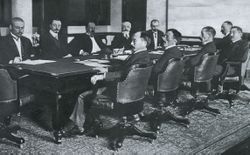
لم يتردد الطرفان المتصارعان في قبول عرض الوساطة التي طرحه الرئيس الأمريكي "تيودور روزفلت"، انتهت الحرب مع توقيع معاهدة في "پورتسمث، نيو هامبشر"، الولايات المتحدة-).
دامت الحرب أكثر مما كان مخططا له، وكانت حصيلة الخسائر المادية والإنسانية مرتفعة. خرج اليابان منتصرا من هذه الحرب. بموجب "معاهدة پورتسمث" والتي تم توقيعها في الـ5 سبتمبر 1905، قامت روسيا بسحب قواتها المتواجدة في كوريا، ضمت اليابان جنوب شبه جزيرة "سخالين"، كما انتقلت إليها العديد من الحقوق الروسية في الصين على غرار الامتيازات التجارية في شبه جزيرة "لياودونگ"، مد خط سكة الحديد في جنوب منشوريا واستغلال مناجم الفحم في "فوشون". رغم هذه التنازلات لم تتحصل اليابان على أية تعويضات عن الخسائر التي لحقتها، اعتبر بعض اليابانيين هذا الأمر بمثابة إهانة لهم، فقامت على إثر ذلك موجة من الاحتجاجات الشعبية.
بعد الحرب الروسية-اليابانية، قام العسكريون في اليابان -والذين أصبحوا يسيطرون على الحكومة- بمنح "إيتو هيروبومي" (رئيس الحكومة) صلاحيات واسعة. بعد مقتله سنة 1909 (على يد أحد القوميين الكوريين)، قرر هؤلاء العسكريين ضم شبه الجزيرة الكورية إلى اليابان، فأصبحت اليابان اللاعب الأول على الساحة الشرق آسيوي، ودام هذا الوضع حتى نهاية الحرب العالمية الثانية.
الخسائر
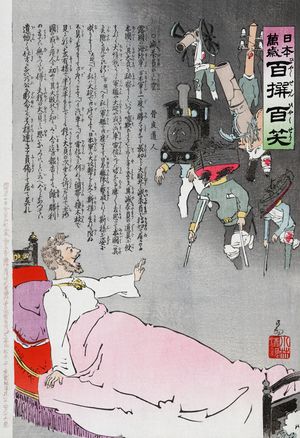
العواقب السياسية
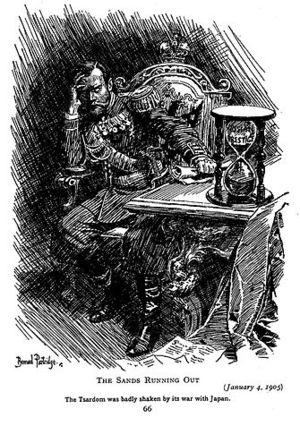
التقييم
الأهمية التاريخية
The Russo-Japanese War introduced a number of characteristics that came to define 20th-century politics and warfare. Many of the innovations brought by the Industrial Revolution, such as rapid-firing artillery and machine guns, as well as more accurate rifles, were first tested on a mass scale. Military operations on both sea and land showed that modern warfare had undergone a considerable change since the Franco-Prussian War of 1870–71.[59][مطلوب توضيح] Most army commanders had previously envisioned using these weapon systems to dominate the battlefield on an operational and tactical level but, as events played out, the technological advances forever altered the conditions of war too.[60]
For East Asia this was the first confrontation in thirty years involving two modern armed forces. The advanced weaponry led to massive casualties. Neither Japan nor Russia had prepared for the number of deaths that would occur in this new kind of warfare, and neither had the resources to compensate for such losses. This also left its impression on society at large, with the emergence of transnational and nongovernmental organizations, like the Red Cross, becoming prominent after the war. The consequent identification of common problems and challenges began the slow process that came to dominate much of the 20th century.[61]
It has also been argued that the conflict had characteristics of what was later to be described as "total war".[62] These included the mass mobilization of troops into battle and the need for so extensive a supply of equipment, armaments, and supplies that both domestic support and foreign aid were required.[59] It is also argued that domestic response in Russia to the inefficiencies of the tsarist government set in motion the eventual dissolution of the Romanov dynasty.[59]
كيف رآها العالم
To the Western powers, Japan's victory demonstrated the emergence of a new Asian regional power. With the Russian defeat, some scholars have argued that the war had set in motion a change in the global world order with the emergence of Japan as not only a regional power, but rather, the main Asian power.[63] Rather more than the possibilities of diplomatic partnership were emerging, however. The US and Australian reaction to the changed balance of power brought by the war was mixed with fears of a Yellow Peril eventually shifting from China to Japan.[64] American figures such as W. E. B. Du Bois and Lothrop Stoddard saw the victory as a challenge to western supremacy.[65] This was reflected in Austria, where Baron Christian von Ehrenfels interpreted the challenge in racial as well as cultural terms, arguing that "the absolute necessity of a radical sexual reform for the continued existence of the western races of men has ... been raised from the level of discussion to the level of a scientifically proven fact". To stop the Japanese "Yellow Peril" would require drastic changes to society and sexuality in the West.[66]
Certainly the Japanese success increased self-confidence among anti-colonial nationalists in colonised Asian countries – Vietnamese, Indonesians, Indians and Filipinos – and to those in declining countries like the Ottoman Empire and Persia in immediate danger of being absorbed by the Western powers.[67][68] It also encouraged the Chinese who, despite having been at war with the Japanese only a decade before, still considered Westerners the greater threat. As Sun Yat-sen commented, "We regarded that Russian defeat by Japan as the defeat of the West by the East. We regarded the Japanese victory as our own victory".[69] Even in far-off Tibet the war was a subject of conversation when Sven Hedin visited the Panchen Lama in February 1907.[70] While for Jawaharlal Nehru, then only an aspiring politician in British India, "Japan's victory lessened the feeling of inferiority from which most of us suffered. A great European power had been defeated, thus Asia could still defeat Europe as it had done in the past."[71] And in the Ottoman Empire too, the Committee of Union and Progress embraced Japan as a role model.[72]
In Europe, subject populations were similarly encouraged. James Joyce's novel Ulysses, set in Dublin in 1904, contains hopeful Irish allusions as to the outcome of the war.[73] And in partitioned Poland the artist Józef Mehoffer chose 1905 to paint his "Europa Jubilans" (Europe rejoicing), which portrays an aproned maid taking her ease on a sofa against a background of Eastern artefacts. Painted following demonstrations against the war and Russian cultural suppression, and in the year of Russia's defeat, its subtly coded message looks forward to a time when the Tsarist masters will be defeated in Europe as they had been in Asia.[74]
The significance of the war was clear too for Socialist thinkers:
The Russo-Japanese War now gives to all an awareness that even war and peace in Europe – its destiny – is not decided between the four walls of the European concert, but outside it, in the gigantic maelstrom of world and colonial politics. And it's in this that the real meaning of the current war resides for social-democracy, even if we set aside its immediate effect: the collapse of Russian absolutism. This war brings the gaze of the international proletariat back to the great political and economic connectedness of the world, and violently dissipates in our ranks the particularism, the pettiness of ideas that form in any period of political calm.
— Rosa Luxemburg، In the Storm، Le Socialiste, May 1–8, 1904 (translator: Mitch Abidor)
النتائج العسكرية
Russia had lost two of its three fleets. Only its Black Sea Fleet remained, and this was the result of an earlier treaty that had prevented the fleet from leaving the Black Sea.[بحاجة لمصدر] Japan became the sixth-most powerful naval force by combined tonnage, while the Russian Navy declined to one barely stronger than that of Austria–Hungary.[75] The actual costs of the war were large enough to affect the Russian economy and, despite grain exports, the nation developed an external balance of payments deficit. The cost of military re-equipment and re-expansion after 1905 pushed the economy further into deficit, although the size of the deficit was obscured.[76]
The Japanese were on the offensive for most of the war and used massed infantry assaults against defensive positions, which would later become the standard of all European armies during World War I. The battles of the Russo-Japanese War, in which machine guns and artillery took a heavy toll on Russian and Japanese troops, were a precursor to the trench warfare of World War I.[77] A German military advisor sent to Japan, Jakob Meckel, had a tremendous impact on the development of the Japanese military training, tactics, strategy, and organization. His reforms were credited with Japan's overwhelming victory over China in the First Sino-Japanese War of 1894–1895. However, his over-reliance on infantry in offensive campaigns also led to a large number of Japanese casualties.
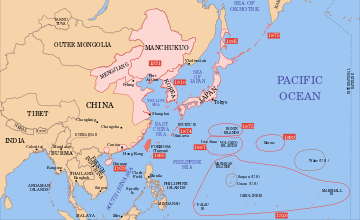
Military and economic exhaustion affected both countries. Japanese historians regard this war as a turning point for Japan, and a key to understanding the reasons why Japan may have failed militarily and politically later. After the war, acrimony was felt at every level of Japanese society, and it became the consensus within Japan that their nation had been treated as the defeated power during the peace conference.[78] As time went on, this feeling, coupled with the sense of "arrogance" at becoming a Great Power, grew and added to growing Japanese hostility towards the West, and fuelled Japan's military and imperial ambitions. Furthermore, Japan's substantiated interests in Korea and Liaodong led to the creation of a Kwantung Army, which became an autonomous and increasingly powerful regional force. Only five years after the war, Japan de jure annexed Korea as part of its colonial empire. Two decades after that, the Kwantung Army staged an incident that led to the invasion of Manchuria in the Mukden Incident; the Kwantung Army eventually came to be heavily involved in the state's politics and administration, leading to a series of localized conflicts with Chinese regional warlords that finally extended into the Second Sino-Japanese War in 1937. As a result, most Chinese historians consider the Russo-Japanese War as a key development in Japan's spiral into militarism in the 1920s–30s.
Following the victory of the Battle of Tsushima, Japan's erstwhile British ally presented a lock of Admiral Nelson's hair to the Imperial Japanese Navy, judging its performance then as on a par with Britain's victory at Trafalgar in 1805. It is still on display at Kyouiku Sankoukan, a public museum maintained by the Japan Self-Defence Force. Nevertheless, there was a consequent shift in British strategic thinking, resulting in enlargement of its naval docks at Auckland, New Zealand; Bombay, British India; Fremantle and Sydney, Australia; Simon's Town, Cape Colony; Singapore and British Hong Kong. The naval war confirmed the direction of the British Admiralty's thinking in tactical terms even as it undermined its strategic grasp of a changing world. Tactical orthodoxy, for example, assumed that a naval battle would imitate the conditions of stationary combat and that ships would engage in one long line sailing on parallel courses; but more flexible tactical thinking would now be required as a firing ship and its target manoeuvred independently.[79]
الملحقون والمراقبون العسكريون
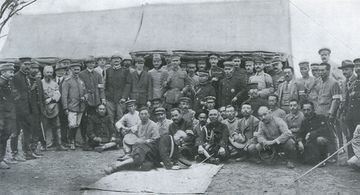
التمويل
Despite its gold reserves of 106.3 million pounds, Russia's pre-war financial situation was not enviable. The country had large budget deficits year after year, and was largely dependent on borrowed money.[80]
Japan's total war expenditure was 2,150 million yen, of which 38%, or 820 million yen, was raised overseas.[81]
List of battles
- 1904 Battle of Port Arthur, 8 February: naval battle inconclusive
- 1904 Battle of Chemulpo Bay, 9 February: naval battle Japanese victory
- 1904 Battle of Yalu River, 30 April to 1 May: Japanese victory
- 1904 Battle of Nanshan, 25 to 26 May, Japanese victory
- 1904 Battle of Te-li-Ssu, 14 to 15 June, Japanese victory
- 1904 Battle of Motien Pass, 17 July, Japanese victory
- 1904 Battle of Tashihchiao, 24 July, Japanese victory
- 1904 Battle of Hsimucheng, 31 July, Japanese victory
- 1904 Battle of the Yellow Sea, 10 August: naval battle Japanese victory strategically, tactically inconclusive
- 1904 Battle off Ulsan, 14 August: naval battle Japanese victory
- 1904–1905 Siege of Port Arthur, 19 August to 2 January: Japanese victory
- 1904 Battle of Liaoyang, 25 August to 3 September: Japanese victory
- 1904 Battle of Shaho, 5 to 17 October: inconclusive
- 1905 Battle of Sandepu, 26 to 27 January: inconclusive
- 1905 Battle of Mukden, 21 February to 10 March: Japanese victory
- 1905 Battle of Tsushima, 27 to 28 May naval battle: Japanese victory
الذكرى الثقافية
الفنون البصرية
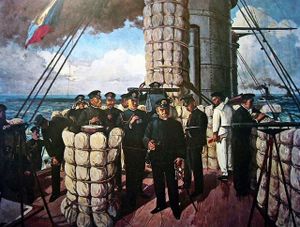
انظر أيضاً
- السياسة الخارجية للامبراطورية الروسية
- Kaneko Kentarō
- Baron Rosen
- Manchuria under Qing rule
- Western imperialism in Asia
- قائمة الحروب
- List of warships sunk during the Russo–Japanese War
- Russian Imperialism in Asia and the Russo–Japanese War
المراجع
- ^ أ ب Mitchell, T.J.; Smith, G.M. (1931). Casualties and Medical Statistics of the Great War. London: HMSO. p. 6. OCLC 14739880.
- ^ أ ب Dumas, S.; Vedel-Petersen, K.O. (1923). Losses of Life Caused By War. Oxford: Clarendon Press. pp. 57–9.
- ^ أ ب Matthew White. "Mid-Range Wars and Atrocities of the Twentieth Century - Russo-Japanese War". Historical Atlas of the Twentieth Century.
- ^ "Serio-comic war map for the year 1877" by Frederick W. Rose (publisher not identified).
- ^ Storry 1979, pp. 15–6.
- ^ Storry 1979, p. 16.
- ^ أ ب ت ث ج ح خ Storry 1979, p. 17.
- ^ Storry 1979, pp. 18–9.
- ^ أ ب ت Storry 1979, p. 20.
- ^ "The Growth of European and Japanese Dominions in Asia since 1801" (Map). University of Texas – Perry–Castañeda Library Map Collection. Cartography by Velhagen & Klasings. Archived from the original on 9 January 2017. Retrieved 25 September 2007.
- ^ أ ب ت ث Hwang 2010, pp. 132–3.
- ^ أ ب ت Hwang 2010, p. 137.
- ^ Jukes 2002, p. 8.
- ^ أ ب ت ث Jukes 2002, p. 9.
- ^ Connaughton 1988, p. 19–20.
- ^ Paine 2003, p. 317.
- ^ Jukes 2002, p. 11.
- ^ Connaughton 1988, p. 7–8.
- ^ Paine 2003, p. 320.
- ^ Katō 2007, p. 96.
- ^ خطأ استشهاد: وسم
<ref>غير صحيح؛ لا نص تم توفيره للمراجع المسماةRöhl2014_269 - ^ خطأ استشهاد: وسم
<ref>غير صحيح؛ لا نص تم توفيره للمراجع المسماةKatō2007_101 - ^ خطأ استشهاد: وسم
<ref>غير صحيح؛ لا نص تم توفيره للمراجع المسماةKodaNWCR2005 - ^ Esthus 1981, p. 411.
- ^ Tolf, Robert W. (1976). The Russian Rockfellers. Hoover Press. p. 156. ISBN 0-8179-6583-1. Archived from the original on 1 November 2020. Retrieved 20 September 2020.
- ^ Esthus 1981, p. 397.
- ^ Baron Komura to Mr. Kurino. 1 December 1903. In Correspondence Regarding Negotiations 1904, p. 38.
- ^ Schimmelpenninck van der Oye 2005, p. 42.
- ^ Jukes 2002, pp. 16–20.
- ^ Jukes 2002, p. 21.
- ^ Some scholarly researchers credit Enjiro Yamaza with drafting the text of the Japanese declaration of war – see Naval Postgraduate School (US) thesis: Na, Sang Hyung. "The Korean-Japanese Dispute over Dokdo/Takeshima," p. 62 n207 Archived 29 يونيو 2011 at the Wayback Machine December 2007, citing Byang-Ryull Kim. (2006). Ilbon Gunbu'ui Dokdo Chim Talsa (The Plunder of Dokdo by the Japanese Military), p. 121.
- ^ "Russo-Japanese War" Archived 12 ديسمبر 2019 at the Wayback Machine, History.com, 21 Aug. 2018
- ^ Gwynn, Stephen, ed. (1929). "Spring Rice to Robert H. M. Ferguson". The Letters and Friendships of Sir Cecil Spring Rice: A Record. Boston: Houghton Mifflin. pp. 402–6. Archived from the original on 10 January 2020. Retrieved 28 October 2021.
- ^ Connaughton 1988, p. 34.
- ^ "Laws of War: Opening of Hostilities (Hague III) 18 October 1907". Yale Law School – Lillian Goldman Law Library – Avalon Project. Archived from the original on 10 February 2011. Retrieved 28 October 2021.
- ^ Hague Conventions of 1899 and 1907 Archived 28 أكتوبر 2021 at the Wayback Machine, Encyclopedia Britannica, Updated 8 June 2019
- ^ Scott, James Brown, editor, The Hague Conventions and Declarations of 1899 and 1907, Oxford University Press, (1918), p. 43 (Title II – On Good Offices and Mediation) Article 2
- ^ Egorov, Boris (2019-02-08). "4 facts about the war in which Russia didn't win a single battle". Russia Beyond (in الإنجليزية الأمريكية). Retrieved 2023-11-05.
- ^ أ ب Jukes 2002, pp. 84–5.
- ^ Tikowara/Grant 1907, p. 48–50.
- ^ Nørregaard, Benjamin Wegner (1906). The Great Siege: The Investment and Fall of Port Arthur. London: Methuen Publishing.
- ^ Sakurai, Tadayoshi (1907). Human bullets, a soldier's story of Port Arthur. Houghton, Mifflin and company.
- ^ Chapman 2004, p. 42.
- ^ Chapman 2004, p. 55.
- ^ Chapman 2004, pp. 52–4.
- ^ Connaughton 1988, p. 65.
- ^ Connaughton 1988, p. 86.
- ^ Forczyk 2009.
- ^ Forczyk 2009, p. 50.
- ^ Forczyk 2009, p. 53.
- ^ Ianfu, the Comfort Women of the Japanese Imperial Army of the Pacific War: Broken Silence: By David A. Schmidt [1] Archived 30 أكتوبر 2021 at the Wayback Machine
- ^ Gold, Hal (13 September 2011). Unit 731: Testimony. Tuttle. ISBN 9781462900824.
- ^ أ ب ت ث Jukes 2002, p. 84.
- ^ أ ب ت Jukes 2002, p. 85.
- ^ "The Forlorn Hope of the Armada. April 1". The Singapore Free Press and Mercantile Advertiser. 6 April 1905. p. 2. Archived from the original on 19 January 2018. Retrieved 19 January 2018.
- ^ Perez, Louis G., ed. (2013). Japan at War – An Encyclopedia. Santa Barbara, CA: ABC-CLIO. p. 345. ISBN 978-159884741-3. Archived from the original on 17 April 2021. Retrieved 20 September 2020.
- ^ Watts 1990, p. 22.
- ^ Mahan 1906, pp. 455–6.
- ^ أ ب ت Steinberg 2008, p. 7.
- ^ Schimmelpenninck van der Oye 2005, p. 84.
- ^ Steinberg 2008, p. 6.
- ^ Steinberg 2008, p. 3.
- ^ Schimmelpenninck van der Oye 2005, p. 83.
- ^ Lyman, Stanford M. (Summer 2000). "The "Yellow Peril" Mystique: Origins and Vicissitudes of a Racist Discourse". International Journal of Politics, Culture, and Society. Springer Publishing. 13 (4): 699. doi:10.1023/A:1022931309651. JSTOR 20020056. S2CID 141218786.
- ^ Heale, M.J. (April 2009). "Anatomy of a Scare: Yellow Peril Politics in America, 1980–1993". Journal of American Studies. Cambridge University Press. 43 (1): 21. doi:10.1017/S0021875809006033. JSTOR 40464347. S2CID 145252539.
- ^ Dickinson, Edward Ross (May 2002). "Sex, Masculinity, and the 'Yellow Peril': Christian von Ehrenfels' Program for a Revision of the European Sexual Order, 1902–1910". German Studies Review. 25 (2): 263. doi:10.2307/1432992. JSTOR 1432992. PMID 20373550.
- ^ Deutschmann, Moritz (2015). Iran and Russian Imperialism: The Ideal Anarchists, 1800–1914. Routledge. p. 158. ISBN 978-1-317-38531-8.
- ^ Banani, Amin (1961). The Modernization of Iran, 1921–1941. Stanford University Press. p. 9. ISBN 978-0-8047-0050-4.
- ^ Sun Yat-sen's speech on Pan-Asianism at Wikisource Archived 18 مارس 2022 at the Wayback Machine
- ^ Sven Hedin, Trans-Himalaya, Asian Educational Services reprint, New Delhi 1999, p. 320 Archived 19 مارس 2018 at the Wayback Machine
- ^ Wells & Wilson 1999, p. 24.
- ^ Worringer, Renée (2014). Ottomans Imagining Japan. London: Palgrave. pp. 53–4. ISBN 978-113738460-7. Archived from the original on 30 October 2020. Retrieved 20 September 2020.
- ^ Ito, Eishiro (December 2007). "United States of Asia, James Joyce and Japan". In Brown, Richard (ed.). A Companion to James Joyce. Blackwell. pp. 195–6. ISBN 978-140511044-0. Archived from the original on 29 August 2021. Retrieved 20 November 2020.
- ^ Crowley, David (January 2008). "Seeing Japan, Imagining Poland: Polish art and the Russo-Japanese war". The Russian Review. 67 (1): 50–69. doi:10.1111/j.1467-9434.2007.00473.x. JSTOR 1432992. See also Faktografia 4 July 2012 Archived 11 مارس 2021 at the Wayback Machine
- ^ Sondhaus, Lawrence (2001). Naval Warfare, 1815–1914. Routledge. p. 192. ISBN 978-041521478-0.
- ^ Strachan 2003, p. 844.
- ^ Keegan 1999, pp. 179, 229, 230.
- ^ خطأ استشهاد: وسم
<ref>غير صحيح؛ لا نص تم توفيره للمراجع المسماةNYT3Sep1905 - ^ Strachan 2003, p. 384, 386, 388.
- ^ Sherman, A.J. (January 1983). "German-Jewish Bankers in World Politics, The Financing of the Russo-Japanese War". Leo Baeck Institute Yearbook. 28 (1): 59–73.
- ^ خطأ استشهاد: وسم
<ref>غير صحيح؛ لا نص تم توفيره للمراجع المسماةHunter93_146
وصلات خارجية
- RussoJapaneseWar.com, Russo-Japanese War research society.
- BFcollection.net, Database of Russian Army Jewish soldiers injured, killed, or missing in action from the war.
- BYU.edu, Text of the Treaty of Portsmouth:.
- Flot.com, Russian Navy history of war.
- Frontiers.loc.gov, Russo-Japanese Relations in the Far East. Meeting of Frontiers (Library of Congress)
- CSmonitor.com, Treaty of Portsmouth now seen as global turning point from the Christian Science Monitor, by Robert Marquand, 30 December 2005.
- The New Student's Reference Work/Russo-Japanese War
- Montenigrina.net, Montenegrins in the Russo-Japanese War (Montenegrin).
- Stanford.edu, Lyrics, translation and melody of the song "On the hills of Manchuria" (Na sopkah Manchzhurii).
- CS1: Julian–Gregorian uncertainty
- CS1 الإنجليزية الأمريكية-language sources (en-us)
- Articles containing روسية-language text
- Articles containing إنگليزية-language text
- مقالات ذات عبارات بحاجة لمصادر
- Wikipedia articles needing factual verification from September 2020
- Articles with hatnote templates targeting a nonexistent page
- جميع الصفحات التي تحتاج تنظيف
- مقالات بالمعرفة تحتاج توضيح from May 2017
- الحرب الروسية اليابانية
- نزاعات 1904
- نزاعات 1905
- حروب روسيا
- حروب الجبل الأسود
- حروب اليابان
- تاريخ كوريا
- تاريخ منشوريا
- 1904 في الصين
- 1905 في الصين
- 1904 في روسيا
- 1905 في روسيا
- 1904 في اليابان
- 1905 في اليابان
- العلاقات العسكرية الروسية اليابانية

